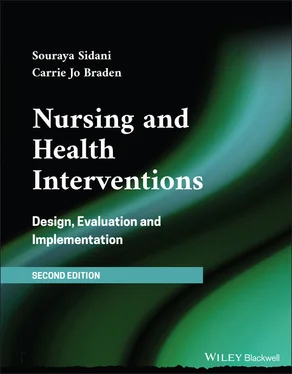1 ...8 9 10 12 13 14 ...26 The terms “intervention,” “treatment,” and “therapy” are interchangeable. Although widely used in written (e.g. books, published research reports) and verbal (e.g. case conference, end of shift report in the practice setting) communications, only a few formal definitions of interventions have been located in recent literature ( Table 2.1). A thorough examination of these definitions points to two key attributes that define interventions. The first attribute is that interventions are essentially activities. They involve the application of specific techniques by the health professional delivering interventions and the clients receiving interventions. The second attribute is rationality. Rationality means that interventions are given in response to an actual or potential health problem, and directed toward attainment of desired goals. Accordingly, interventions are sets of activities performed by health professionals and clients, independently or collaboratively, to address problems experienced by clients and to achieve beneficial outcomes.
Interventions are more specific than strategies. Strategies provide general principles informing the generation of new or the selection of available evidence‐based techniques. For instance, a behavioral conceptualization of chronic insomnia provided guidance for developing the stimulus control therapy. The stimulus control therapy consists of specific recommendations for sleep behaviors (known to perpetuate insomnia) to do or avoid, and specific techniques to assist clients in carrying out these recommendations. The techniques include providing information on the association between sleep behaviors and insomnia, prompting identification of barriers and possible solutions, and encouraging self‐monitoring of sleep behaviors and parameters. These three specific techniques are described as replicable behavior change techniques designed to alter behaviors (Abraham & Michie, 2008; Carey et al., 2018).
TABLE 2.1 Formal definitions of interventions.
| Field |
Definition |
Reference |
| Nursing |
Deliberate cognitive, physical, or verbal activities performed with, or on behalf of, individuals and their families, that are directed toward accomplishing particular therapeutic objectives relative to individuals' health and well‐being |
Grove et al. (2015) |
|
Actions, treatments, or technologies, that are physical, psychological, social in nature, with predicted outcomes |
Forbes (2009) |
| Public health |
Planned actions to prevent or reduce a particular health problem or the determinants of the problem |
Wight et al. (2015) |
|
An act performed for, with, or on behalf of a person or population with the purpose to assess, improve, promote, or modify health, functioning, or health conditions |
Cambon et al. (2019) |
| Behavior health |
Coordinated sets of activities or techniques introduced at a given time and place to change the behavior of individuals, communities, or populations through a hypothesized or known mechanism |
Araújo‐Soares et al. (2018) |
| Social/implementation science |
Events within systems, aimed to disrupt the functioning of complex systems through changing relationships, displacing entrenched practice, and redistributing and transforming resources |
Moore et al. (2019) |
|
Attempts to disrupt mechanisms which perpetuate and sustain a problem in a given time and place |
Moore and Evans (2017) |
| Program evaluation |
Specific activities undertaken to make a positive difference in outcomes |
Mayne (2015) |
Programs, complex interventions, and multicomponent interventions consist of multiple interventions that have been grouped into a package. The package is often designed to address: (1) a health problem that is conceptualized from different perspectives and experienced in different domains of health (e.g. cognitive and behavioral, as is the case with chronic insomnia); (2) a health problem that is attributable to a range of determinants occurring in different domains of health (e.g. physical, psychological, social) and at different levels (e.g. individual, community, healthcare system); or (3) co‐occurring and inter‐related health problems (e.g. comorbidity or multi‐morbidity that is, the presence of multiple acute and chronic conditions among older adults). Examples of programs are provided in Table 2.2.
2.2 INTERVENTION ELEMENTS
Interventions are described in terms of the goals they are set to achieve and the components comprising them.
Interventions are designed to attain one or more goals related to a particular health problem. An intervention goal is a statement of what exactly the intervention is expected to achieve relative to the health problem it targets. Some interventions aim to modify the determinants or causes of the health problem and, hence, to prevent its occurrence. For example, changing a nonambulatory client's position in bed every two hours aims to prevent pressure ulcer, and instructing clients with asthma to avoid irritants such as dust and smoke is directed at preventing dyspnea. Other interventions are designed to manage the health problem, to reduce its burden, and/or to mitigate its negative consequences. For instance, taking a medication is useful in self‐managing muscle pain whereas listening to music is helpful in reducing the emotional reactions to pain such as anxiety (i.e. its burden); both interventions relieve pain and minimize its contribution to limited physical functioning (i.e. its negative consequences). Other interventions are directed at promoting engagement in health‐related behaviors such as physical activity and smoking cessation and consequently, enhancing general health and well‐being.
2.2.2 Intervention Components
Interventions are comprised of one or more components. A component is a set of activities or techniques that are directed toward addressing a common goal. For example, the multicomponent intervention for insomnia described in Table 2.2consists of four components, each addressing one goal: (1) sleep education and hygiene aims to help clients understand the factors that perpetuate insomnia, and the general behavioral and environmental recommendations to promote a good night's sleep; (2) stimulus control therapy focuses on reassociating the bed with sleep; (3) sleep restriction therapy aims to consolidate sleep; and (4) behavior change support is set to facilitate clients' initiation, engagement, and adherence to all treatment recommendations in their daily life context.
TABLE 2.2 Examples of programs or multicomponent interventions.
| Health problem |
Chronic insomnia |
Stroke and multi‐morbidity |
Promotion of physical health |
| Program/intervention name |
Multicomponent intervention |
Hospital‐to‐home transitional care intervention |
For health, I move in my neighborhood! |
| Description |
Sleep education and hygieneDiscussion of factors that contribute to insomniaPresentation of behavioral and environmental recommendations to promote a good night's sleepStimulus control therapyDiscussion of instructions for sleep‐related behaviorsApplication of recommendations in daily lifeSleep restriction therapyIdentification of sleep needsWorking out a sleep–wake scheduleApplication of schedule in daily lifeBehavior change supportIdentification of barriers and strategies to overcome barriers to the application of recommendations in daily lifeSelf‐monitoring of sleep behaviors and sleep parameters |
Person‐centered careComprehensive health assessmentMedication review and reconciliationSelf‐management education and supportProvision of caregiver supportCare coordination/system navigationIn‐person (inter‐professional case conferences) and electronic (web‐based application) communication among health professionalsTimely referral to appropriate health professionals and community resources |
.Improved offering and accessibility to physical activityProvision of new activities (e.g. walking, yoga) in schoolsCommunication about physical activity (i.e. information about benefits of physical activity)Distribution of flyers or brochuresPhysical activity instructor's visits to different structures (e.g. schools, community centers) and availability for consultationSports festivalEnvironmental changesOrientation pathways (i.e. information on distance and duration of walk to different services)Provision of additional sports devices at community centersUrban redevelopmentRoad work (e.g. bike path, widening sidewalk)Redevelopment of green areas“Shape and Health Challenge” programPhysical and sports activities program |
| Reference |
Adapted from Sidani et al. (2019) |
Adapted from Markle‐Reid et al. (2019) |
Adapted from Buscail et al. (2016) |
There are two categories of intervention components: specific and nonspecific. Specific components are unique and essential in distinguishing the intervention. They represent the “active ingredients,” which are theoretically hypothesized to bring about the intended changes in the health problem and to produce related beneficial outcomes (Carey et al., 2018; Kühne et al., 2015; Michie et al., 2009). The nonspecific components are techniques used to enable, support, reinforce, or facilitate the implementation of the intervention's specific components (Sidani et al., 2020). Nonspecific components are usually not unique to a particular intervention and, therefore, are not expected to contribute significantly to the intended beneficial outcomes (Araújo‐Soares et al., 2018). Recent evidence, however, suggests that nonspecific components, in combination with the way the intervention is delivered, may enhance or undermine its effectiveness (Dombrowski et al., 2016). For example, sleep education and hygiene, stimulus control therapy and sleep restriction therapy are specific components of the multicomponent intervention for insomnia. The behavior change support is a nonspecific component because it is generic and can be integrated in other health behavior change interventions.
Читать дальше












